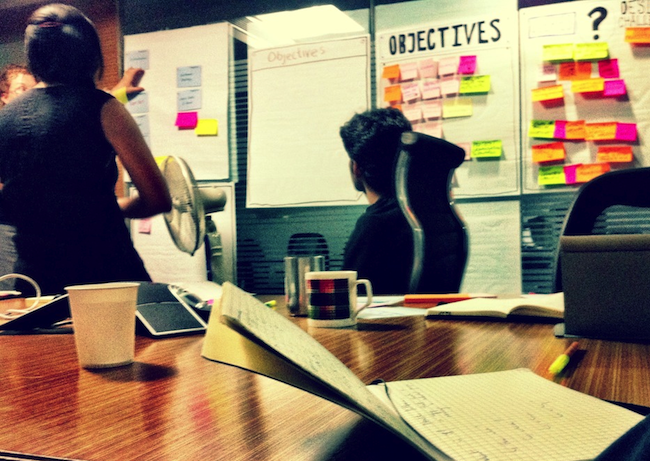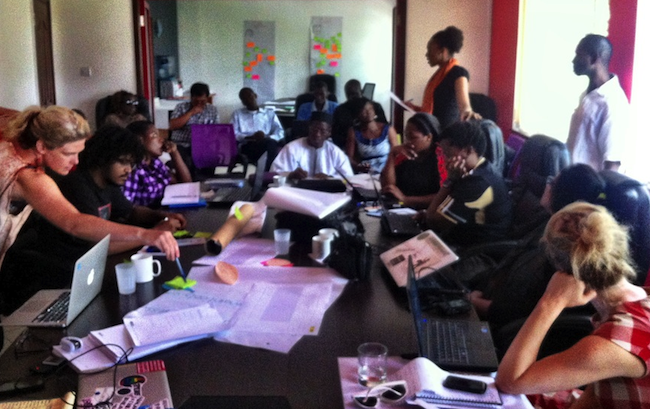
Evolving Products with People-Focused Research
How do you turn a mobile phone into an alert system for activists?
Over the course of a year, Thoughtworks worked with Amnesty International – a global movement of more than 3 million activists who campaign to end grave abuses of human rights – to investigate a wicked problem and posit an answer to the ill-defined space. This article tells a software story all about collaboration and iteration, illustrating how continuous delivery and human-centered design pairs with research and human rights innovation.
The story begins in London, April 2012, when two Thoughtworkers – Jill Irving and Amir Nagri – attended an OpenIDEO Make-a-thon. They picked a challenge posed by Amy Bosnall to quickly design and develop an app that would explore how technology could support people who faced unlawful detention.
24 hours later, with the help of Amnesty activists, they had built an app. They called it the Panic Button.
After building this first prototype, Amnesty requested Thoughtworks build out a more robust version that would allow activists out in the field to safely contact a guardian network during periods of emergencies. Ange Ashworth, a Client Principal in our London office, picked up the project, figuring out how Thoughtworks could partner across industries so an idea could turn into a working piece of software.
In June, I was privileged to be on a team of 12*, based in Bangalore, which picked up the first phase of development. We worked closely with our Product Owners, Tanya O’Carroll and Owen Pringle, to deliver a Proof of Concept prototype.
To get a better understanding of the problem, our team went through a series of stakeholder interviews and inception activities to understand the possible use case scenarios.

We knew there wasn’t much we could do in terms of building an app that the intelligence community couldn’t hack into, so we focused on building the minimum viable product that would actually live up to its use case – contacting people in a moment of emergency and hiding itself during a possible unlawful detention on the street or at home.
We started by understanding the personas with Amnesty, then working with Tanya and Lead Designer Diana Adorno to map these activists' journey out in the field. Mapping a basic journey enabled us to understand the context in which activists could use the app and allowed us to hold a design session that focused on constructing an app based on their needs, rather than our blue-sky ideas.
From there, we generated a strategy and simple design that would disguise the app. This process, from initial discovery to quickstart development, allowed us to analyze the complex problem space and create a result that the context required.
Continuous delivery meant by the end of 8 weeks we had released a working Android prototype built in Java. This prototype allowed us to go out and conduct a field-based focus group at PAWA254, along with brainstorming and ideation workshops. I was very lucky to attend, as we were able to actually test our prototype with real activists, which was the key for Amnesty to understand the priorities of the next phase. The environment challenged our hypothesis about ease of use and needs, helping Thoughtworks discover usability blockers and drive real improvement for the next round of development.
Focusing on outcomes over outputs, we integrated design thinking with business operations for deliberate product evolution.
Journey mapping, thinkalouds and bodystorming
In the field, there was three activities that we helped us better understand our constituents: journey mapping, thinkalouds and bodystorming.
- Journey mapping With direction provided by Seren, a research and design firm based in London, we gave each participant a pen, asking them to map typical situations in which panic was felt. For some, this was just a regular day at home, for others it was more deliberate participation in a planned action. Because there were a wide variety of scenarios that could change the nature of how the app would be used, we collaboratively navigated the experience space, working with them to be as detailed and clear in our understanding as possible. And instead of just using journey map templates, we captured information together on big A3 paper, allowing us all to expand our thoughts outside the limitations of tiny paper.
- Thinkalouds. Pairing with Amnesty researcher Danna Ingleton, we used thinkalouds to see how people were reacting to the prototype. Thinkalouds are simple usability tests where people literally think aloud. Jakob Nielsen, of the Nielsen Norman Group, has described it as the #1 usability tool. The think-aloud protocol is used to test overall product comprehension, rather than basic task completion. It helps you understand people by asking them to verbalize their thoughts as they complete actions. The key here for us was to watch activists fiddle with the prototype and silently evaluate its usability. Thinkalouds ensured that we were with them at every step of the product and allowed to understand their mental model.
- Bodystorming. Lastly, with the aid of design thinkers like Mark Kamau and Kagonya Awori of Nairobi’s iHub UX Lab, we held some bodystorming sessions. Bodystorming is observation and documentation through design acting. It’s basically like roleplaying to build products that understand real use case scenarios. We used bodystorming as part of a larger “Design Day” aimed at understanding how activists felt about product opportunities. The activity was meant to be fun, but still allowed us to get in each other’s shoes and empathise with the challenges we collectively face. Employing the technique afforded us a thorough appreciation of the physical, social and psychological factors we would need to keep in mind whenever developing for people in the human rights space.

Activities like journey mapping and thinkalouds help adapt software to the constraint, focusing more on the people rather than the technology. People-focused activities like bodystorming fuels product evolution, enabling greater perspective to the software you build. Overall, these methods are more than just creative exercises, they’re effective tools for building apps. They allow teams to focus on the bigger questions of the problem space, rather than just focusing on the development solution or the beauty of the user interface.
After these two phases, the app was picked up by a new development team based in Chennai**, along with James Cook, an Experience Designer based in our Thoughtworks London office. Together with Tanya, Jeff Wishnie and Bart Stidham, the new team re-imagined the user interface and bolstered the security, working with the Amnesty global team to get it distribution-ready.
The application went on to be awarded £100,000 through Google’s Impact Awards, proving the future is in creating mobile strategies based on empathy, understanding, and collaboration. Employing techniques like the ones mentioned above allowed Amnesty International to work with a variety of partners and create a digital tool for human rights defenders, discovering where innovation work fits in their digital landscape while letting Thoughtworks explore new territory in building technology for human rights.
Thanks to Tanya O’Carroll for reviewing this story.
* Bangalore team included: Solon Aguilar, Manasi Kulkarni, Rachel Walker, Mewanbanjop Mawroh, Kavitha R, Praveenram B A, Satyam Agarwala, Mingming Bai, Quazi Mohd, Scott Robinson, Amir Nagri
** Chennai team included: Sriram Narasimhan, Karthik "CK" Chandraraj, Jeyakar Vaiz Issam, Muhammed Siddique
Disclaimer: The statements and opinions expressed in this article are those of the author(s) and do not necessarily reflect the positions of Thoughtworks.














